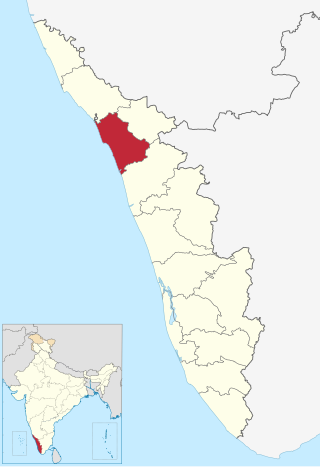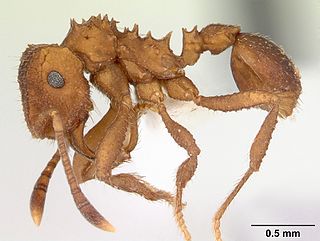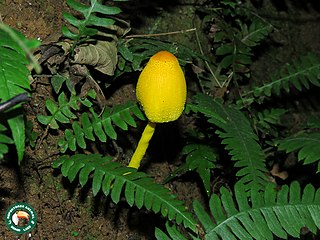
Leafcutter ants, a non-generic name, are any of 47 species of leaf-chewing ants belonging to the two genera Atta and Acromyrmex, within the tribe Attini. These species of tropical, fungus-growing ants are all endemic to South and Central America, Mexico, and parts of the southern United States. Leafcutter ants can carry twenty times their body weight and cut and process fresh vegetation to serve as the nutritional substrate for their fungal cultivates.

Fungus-growing ants comprise all the known fungus-growing ant species participating in ant–fungus mutualism. They are known for cutting grasses and leaves, carrying them to their colonies' nests, and using them to grow fungus on which they later feed.

The ant–fungus mutualism is a symbiosis seen between certain ant and fungal species, in which ants actively cultivate fungus much like humans farm crops as a food source. There is only evidence of two instances in which this form of agriculture evolved in ants resulting in a dependence on fungi for food. These instances were the attine ants and some ants that are part of the Megalomyrmex genus. In some species, the ants and fungi are dependent on each other for survival. This type of codependency is prevalent among herbivores who rely on plant material for nutrition. The fungus’ ability to convert the plant material into a food source accessible to their host makes them the ideal partner. The leafcutter ant is a well-known example of this symbiosis. Leafcutter ants species can be found in southern South America up to the United States. However, ants are not the only ground-dwelling arthropods which have developed symbioses with fungi. A similar mutualism with fungi is also noted in termites within the subfamily Macrotermitinae which are widely distributed throughout the Old World tropics with the highest diversity in Africa.

Mycocepurus smithii is a species of fungus-growing ant from Latin America. This species is widely distributed geographically and can be found from Mexico in the north to Argentina in the south, as well as on some Caribbean Islands. It lives in a variety of forested habitats and associated open areas. Two studies published in 2009 demonstrated that some populations of the species consist exclusively of females which reproduce via thelytokous parthenogenesis. A detailed study found evidence of sexual reproduction in some populations in the Brazilian Amazon. Accordingly, M. smithii consists of a mosaic of sexually and asexually reproducing populations. In asexual populations all ants in a single colony are female clones of the queen. Inside the colony, the ants cultivate a garden of fungus grown with pieces of dead vegetable matter, dead insects, and insect droppings.

Leucoagaricus is a genus of mushroom-forming fungi in the family Agaricaceae. As of March 2023 there are over 200 accepted species of Leucoagaricus with ongoing research into the genus adding several more each year. Leucocoprinus is a similar genus and considered by some sources to be indistinct from Leucoagaricus based on genetic data that demonstrates they are monophyletic. Species are separated into these genera based on macroscopic features such as cap striations in Leucocoprinus or the more persistent basidiocarps (mushrooms) of Leucoagaricus as well as microscopic features such as the lack of a germ pore in Leucoagaricus species. As a result of the similarities and disagreement on taxonomy, many of the species within these genera have formerly been classified in the other and may still be known by previous classifications. For instance the species Leucoagaricus gongylophorus is cultivated by fungus-growing ants but was formerly known as Leucocoprinus gongylophorus whilst other species cultivated by the lesser attine ants are still classified as undescribed Leucocoprinus species.

Lepiota zalkavritha is an agaric fungus of the genus Lepiota, order Agaricales. Described as new to science in 2009, it is found in Kerala State, India.
Mycocepurus castrator is a species of parasitic ant, in the genus Mycocepurus, native to Brazil. Described in 2010, the species is a workerless and obligate parasite of the related ant Mycocepurus goeldii. It is known only from Rio Claro, Brazil, and has only been found in nests of M. goeldii.

Mycocepurus goeldii is a species of ant in the genus Mycocepurus.

Escovopsis is a genus of seven formally acknowledged parasitic microfungus species that rely on other fungi to be their hosts. This genus formally circumscribed with a single identified species in 1990; in 2013 three other species were added.
Escovopsis aspergilloides is a species of fungus that was rediscovered in 1995 by mycologists Keith A. Seifert, Robert A. Samson and Ignacio Chapela. Escovopsis aspergilloides co-exist in a symbiotic relationship with attini ants - fungus-growing ants. The highly evolved, ancient ant-fungus mutualism has become a model system in the study of symbiosis. In spite of this, the genus Escovopsis was not proposed until 1990 and the first two species were not formally described until the 1990s: E. weberi by Muchovej and Della Lucia in 1990 E. aspergilloides by Seifert, Samson and Chapela in 1995.

Leucoagaricus gongylophorus is a fungus in the family Agaricaceae which is cultivated by certain leafcutter ants. Like other species of fungi cultivated by ants, L. gongylophorus produces gongylidia, nutrient-rich hyphal swellings upon which the ants feed. Production of mushrooms occurs only once ants abandon the nest. L. gongylophorus is farmed by leaf cutter ant species belonging to the genera Atta and Acromyrmex, amongst others.

Leucocoprinus ianthinus is a species of mushroom producing fungus in the family Agaricaceae. Like several other Leucocoprinus species it may have originated in a tropical climate but now finds a home in plant pots, greenhouses and compost piles in many countries. It is not seen in plant pots with the same kind of regularity as the well known Leucocoprinus birnbaumii and not seen in the wild as frequently as Leucocoprinus brebissonii.

Leucocoprinus brunneoluteus is a species of mushroom producing fungus in the family Agaricaceae.
Leucocoprinus delicatulus is a species of mushroom producing fungus in the family Agaricaceae.
Leucocoprinus munnarensis is a species of mushroom producing fungus in the family Agaricaceae.
Leucocoprinus rhodolepis is a species of mushroom producing fungus in the family Agaricaceae.
Leucocoprinus canariensis is a species of mushroom producing fungus in the family Agaricaceae.
Leucoagaricus flavus is a species of mushroom-producing fungus in the family Agaricaceae.
Leucocoprinus minutulus is a species of mushroom producing fungus in the family Agaricaceae.
Leucocoprinus dunensis is a species of mushroom-producing fungus in the family Agaricaceae.










